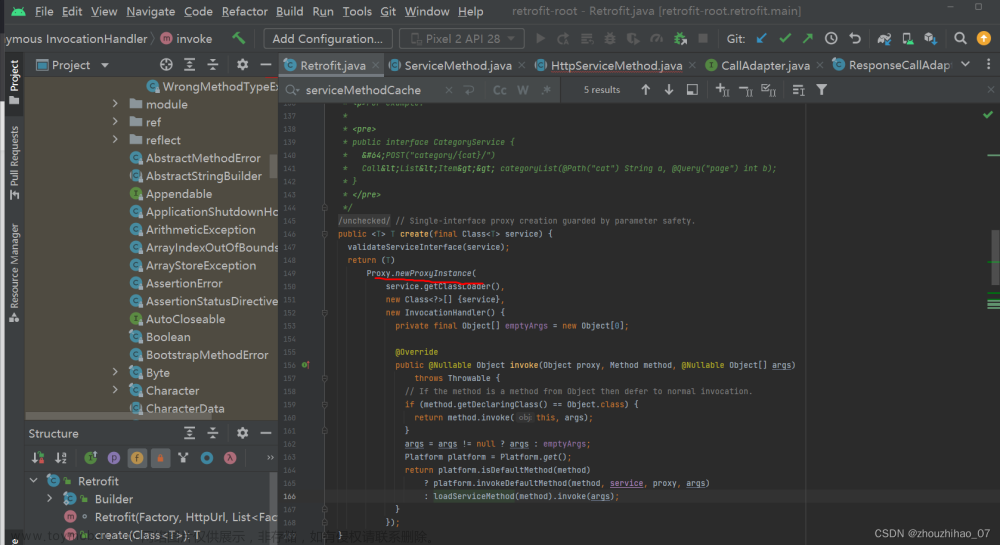Reflection 源码分析
定义
Java的反射(reflection)机制是指在程序的运行状态中,可以构造任意一个类的对象,可以了解任意一个对象所属的类,可以了解任意一个类的成员变量和方法,可以调用任意一个对象的属性和方法。这种动态获取程序信息以及动态调用对象的功能称为Java语言的反射机制。反射被视为动态语言的关键
Class对象
-
Class对象是JVM生成用来保存对象的类的信息的。Java程序执行之前需要经过编译、加载、链接和初始化这几个阶段,编译阶段会将源码文件编译为
.class字节码文件,编译器同时会在.class文件中生成Class对象,加载阶段通过JVM内部的类加载机制,将Class对象加载到内存中。在创建对象实例之前,JVM会先检查Class对象是否在内存中存在,如果不存在,则加载Class对象,然后再创建对象实例,如果存在,则直接根据Class对象创建对象实例。JVM中只有一个Class对象,但可以根据Class对象生成多个对象实例。 -
获取Class对象的三种方式
-
1.Class.forName方式 传全限定类名
public class Cat { private int age; private String name; public static void main(String[] args) throws ClassNotFoundException { Class<?> c1 = Class.forName("org.yrdm.ch1.Cat"); System.out.println(c1); } } 结果: class org.yrdm.ch1.Cat -
- 调用类实例对象的getClass()方法,继承于Object类的getClass()方法
public class Cat { private int age; private String name; public static void main(String[] args) { Cat cat=new Cat(); Class c1 = cat.getClass(); System.out.println(c1); } } 结果: class org.yrdm.ch1.Cat -
3.通过类名 .class文章来源:https://www.toymoban.com/news/detail-433391.html
public class Cat { private int age; private String name; public static void main(String[] args) { Class c1 = Cat.class; System.out.println(c1); } } 结果: class org.yrdm.ch1.Cat
-
-
Class类源码分析文章来源地址https://www.toymoban.com/news/detail-433391.html
//泛型类 public final class Class<T> implements java.io.Serializable,GenericDeclaration,Type,AnnotatedElement { //重要方法 //获取Class对象 static修饰 @CallerSensitive public static Class<?> forName(String className) throws ClassNotFoundException { Class<?> caller = Reflection.getCallerClass(); return forName0(className, true, ClassLoader.getClassLoader(caller), caller); } //创建实例,直接调用无参构造进行构造 jdk9后被弃用,使用class.getDeclaredConstructor().newInstance()代替 @CallerSensitive @Deprecated(since="9") public T newInstance() throws InstantiationException, IllegalAccessException {...} //每个结构都有这四件套 getXXX() getXXXs() getDealaredXXX() getDeclaredXXXs() //1.属性 //根据参数获取属性 public 属性 @CallerSensitive public Field getField(String name){...} //获取所有public属性,返回属性数组 @CallerSensitive public Field[] getFields() throws SecurityException { ... } //Returns an array of Field objects reflecting all the fields declared by the class or interface represented by this Class object. 获取所有属性,public protected default private @CallerSensitive public Field[] getDeclaredFields() throws SecurityException { ... } //Returns a Field object that reflects the specified declared field of the class or interface represented by this Class object. @CallerSensitive public Field getDeclaredField(String name) throws NoSuchFieldException, SecurityException { ... } //2.获取方法 //(1).getMethod name为方法名,因为重载的缘故根据后面的可变长参数来指定特定的方法 @CallerSensitive public Method getMethod(String name, Class<?>... parameterTypes) throws NoSuchMethodException, SecurityException { ... } //(2).getMethods() @CallerSensitive public Method[] getMethods() throws SecurityException { ... } //(3)getDeclaredMethods() @CallerSensitive public Method[] getDeclaredMethods() throws SecurityException { 。。。 } //(4).getDeclaredMethod() @CallerSensitive public Method getDeclaredMethod(String name, Class<?>... parameterTypes) throws NoSuchMethodException, SecurityException { ... } //3.获取构造函数 @CallerSensitive public Constructor<T> getConstructor(Class<?>... parameterTypes) throws NoSuchMethodException, SecurityException { } @CallerSensitive public Constructor<?>[] getConstructors() throws SecurityException { } @CallerSensitive public Constructor<T> getDeclaredConstructor(Class<?>... parameterTypes) throws NoSuchMethodException, SecurityException { ... } @CallerSensitive public Constructor<?>[] getDeclaredConstructors() throws SecurityException { } //4.获取所实现的接口 public Class<?>[] getInterfaces() { ... } public Type[] getGenericInterfaces() { } //5.获取父类 public Type getGenericSuperclass() { ... } //6.获取注解 public <A extends Annotation> A getAnnotation(Class<A> annotationClass) { } public Annotation[] getAnnotations() { return AnnotationParser.toArray(annotationData().annotations); } public <A extends Annotation> A getDeclaredAnnotation(Class<A> annotationClass) { Objects.requireNonNull(annotationClass); return (A) annotationData().declaredAnnotations.get(annotationClass); } public Annotation[] getDeclaredAnnotations() { return AnnotationParser.toArray(annotationData().declaredAnnotations); } //7.获取类中定义的类和嵌套接口 @CallerSensitive public Class<?>[] getClasses() { ... } @CallerSensitive public Class<?>[] getDeclaredClasses() throws SecurityException { SecurityManager sm = System.getSecurityManager(); if (sm != null) { checkMemberAccess(sm, Member.DECLARED, Reflection.getCallerClass(), false); } return getDeclaredClasses0(); } //8.获取当前类的加载器 @CallerSensitive @ForceInline // to ensure Reflection.getCallerClass optimization public ClassLoader getClassLoader() { ClassLoader cl = getClassLoader0(); if (cl == null) return null; SecurityManager sm = System.getSecurityManager(); if (sm != null) { ClassLoader.checkClassLoaderPermission(cl, Reflection.getCallerClass()); } return cl; } //9.其他 public Module getModule() { return module; } public String getName() { String name = this.name; return name != null ? name : initClassName(); } public Package getPackage() { if (isPrimitive() || isArray()) { return null; } ClassLoader cl = getClassLoader0(); return cl != null ? cl.definePackage(this) : BootLoader.definePackage(this); } public String getPackageName() { ... } //Finds a resource with a given name. @CallerSensitive public URL getResource(String name) { ... } @CallerSensitive public InputStream getResourceAsStream(String name) {} }
URL类
- Class.getResource() 返回URL类
public final class URL implements java.io.Serializable {
/**
* The protocol to use (ftp, http, nntp, ... etc.) .
* @serial
*/
private String protocol;
/**
* The host name to connect to.
* @serial
*/
private String host;
/**
* The protocol port to connect to.
* @serial
*/
private int port = -1;
/**
* The specified file name on that host. {@code file} is
* defined as {@code path[?query]}
* @serial
*/
private String file;
/**
* The query part of this URL.
*/
private transient String query;
/**
* The authority part of this URL.
* @serial
*/
private String authority;
/**
* The path part of this URL.
*/
private transient String path;
/**
* The userinfo part of this URL.
*/
private transient String userInfo;
/**
* # reference.
* @serial
*/
private String ref;
...
}
代码转载自:
*****https://geek-docs.com/java/java-url/g_url-class-java-examples.html************
// Java program to demonstrate working of URL
// Importing required classes
import java.net.MalformedURLException;
import java.net.URL;
// Main class
// URL class
public class GFG {
// Main driver method
public static void main(String[] args)
throws MalformedURLException
{
// Creating a URL with string representation
URL url1 = new URL(
"https://www.google.co.in/?gfe_rd=cr&ei=ptYq"
+ "WK26I4fT8gfth6CACg#q=geeks+for+geeks+java");
// Creating a URL with a protocol,hostname,and path
URL url2 = new URL("http", "www.geeksforgeeks.org",
"/jvm-works-jvm-architecture/");
URL url3 = new URL(
"https://www.google.co.in/search?"
+ "q=gnu&rlz=1C1CHZL_enIN71"
+ "4IN715&oq=gnu&aqs=chrome..69i57j6"
+ "9i60l5.653j0j7&sourceid=chrome&ie=UTF"
+ "-8#q=geeks+for+geeks+java");
// Printing the string representation of the URL
System.out.println(url1.toString());
System.out.println(url2.toString());
System.out.println();
System.out.println(
"Different components of the URL3-");
// Retrieving the protocol for the URL
System.out.println("Protocol:- "
+ url3.getProtocol());
// Retrieving the hostname of the url
System.out.println("Hostname:- " + url3.getHost());
// Retrieving the default port
System.out.println("Default port:- "
+ url3.getDefaultPort());
// Retrieving the query part of URL
System.out.println("Query:- " + url3.getQuery());
// Retrieving the path of URL
System.out.println("Path:- " + url3.getPath());
// Retrieving the file name
System.out.println("File:- " + url3.getFile());
// Retrieving the reference
System.out.println("Reference:- " + url3.getRef());
}
}
运行结果:
https://www.google.co.in/?gfe_rd=cr&ei=ptYqWK26I4fT8gfth6CACg#q=geeks+for+geeks+java
https://www.geeksforgeeks.org/jvm-works-jvm-architecture/
Different components of the URL3-
Protocol:- https
Hostname:- www.google.co.in
Default port:- 443
Query:- q=gnu&rlz=1C1CHZL_enIN714IN715&oq=gnu&aqs=chrome..69i57j69i60l5.653j0j7&sourceid=chrome&ie=UTF-8
Path:- /search
File:- /search?q=gnu&rlz=1C1CHZL_enIN714IN715&oq=gnu&aqs=chrome..69i57j69i60l5.653j0j7&sourceid=chrome&ie=UTF-8
Reference:- q=geeks+for+geeks+java
ClassLoader
- java 类加载过程(暂时挖个坑,后面填
到了这里,关于Reflection java反射源码分析的文章就介绍完了。如果您还想了解更多内容,请在右上角搜索TOY模板网以前的文章或继续浏览下面的相关文章,希望大家以后多多支持TOY模板网!

![[Unity/URP学习]反射探针(Reflection Probe)](https://imgs.yssmx.com/Uploads/2024/01/406016-1.png)









